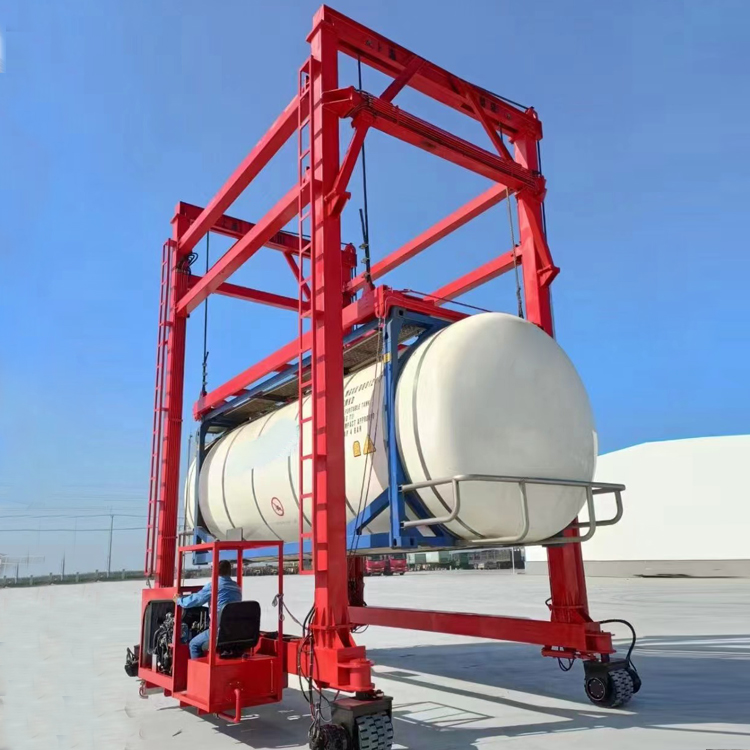In ports, railway freight yards, and large logistics centers around the world, a massive yet agile machine operates efficiently—the rubber-tyred gantry crane, also known as the rubber-tyred container gantry crane (RTG). Its rubber tires serve as its “legs,” and its gantry frame structure and intelligent systems have made it a core piece of modern logistics equipment. This article will provide a deeper understanding of the appeal of this machine.
I. Definition and Structure: The Perfect Balance of Mobility and Stability
A rubber-tyred gantry crane is a type of lifting equipment mounted on pneumatic rubber tires, primarily used for container loading, unloading, and stacking. Its core structure includes:
Gantry frame: Consisting of a main beam and outriggers, it withstands enormous loads, typically spanning 23.47 meters (customizable spans are available), and can cover six rows of containers and aisles.
Power System: Traditional models rely on diesel generators, while modern models incorporate clean energy solutions such as lithium batteries and mains electricity, achieving an upgrade from oil to electricity. Intelligent Spreader: Equipped with a telescopic spreader, it can handle 20-foot to 40-foot containers. Integrated mechanical anti-roll devices and small-angle rotation ensure precise alignment.
Travel Mechanism: Available with 8- or 16-wheel drive, it supports straight and transverse travel, 90° turns, and 360° pivoting, adapting to complex sites.
II. Application Scenarios: An All-Rounder from Ports to Construction Sites
The mobility of rubber-tired gantry cranes (RTGs) makes them widely used in the following areas:
Port Container Yards: Serving as “yard cranes,” they connect directly to shore-side loading and unloading bridges to transfer containers from ships to the yard, handling over 60 lifts per day. For example, the electric RTGs used at Ningbo-Zhoushan Port significantly improve loading and unloading efficiency through AI-powered visual monitoring and automated positioning systems.
Railway Freight Yards and Logistics Centers: Their flexible mobility enables rapid response to multi-regional operational needs, reducing the cost of secondary handling of goods. After adopting a 50-ton RTG, an inland port saved approximately 1 million yuan annually in site rental costs.
Infrastructure construction sites: The RTG’s hydraulic suspension system and explosion-proof tires maintain stability even on muddy or uneven surfaces, improving steel structure lifting efficiency by 30% compared to traditional crawler cranes.
III. Core Advantages: A Double Breakthrough in Efficiency and Cost
Compared to rail-mounted cranes, rubber-tired gantry cranes offer significant advantages:
Ultimate Flexibility: Eliminating the need for fixed rails, rubber-tired gantry cranes can be freely moved to accommodate temporary sites and complex terrain. For example, one port increased yard utilization by 50% using the RTG’s free-steering technology.
Energy Conversion: All-electric RTGs (E-RTGs), powered by busbars or cable drums, can reduce annual carbon emissions from 284 tons to 33 tons, equivalent to planting 1,800 trees.
Hybrid Solutions: A combination of a diesel generator and batteries reduces fuel consumption by 37%, while also enabling rapid battery swaps, allowing for a full charge in 5-10 minutes. Intelligent Upgrades:
Remote Control: Operators can remotely control equipment from a ground-based intelligent monitoring center using 68 cameras, doubling efficiency and eliminating the risks of working at height.
Predictive Maintenance: The Internet of Things (IoT) and big data analytics monitor equipment status in real time. For example, Shandong Qiming Heavy Industries’ CMS system can provide early warning of failures, reducing operation and maintenance costs by 25%.

Post time: Aug-21-2025







